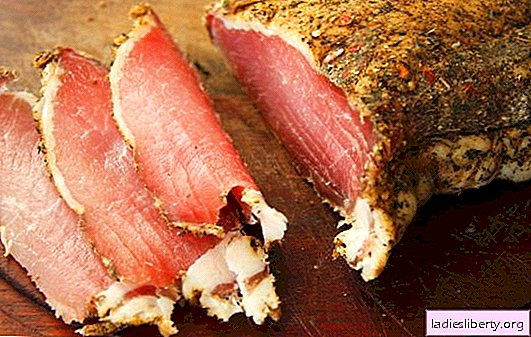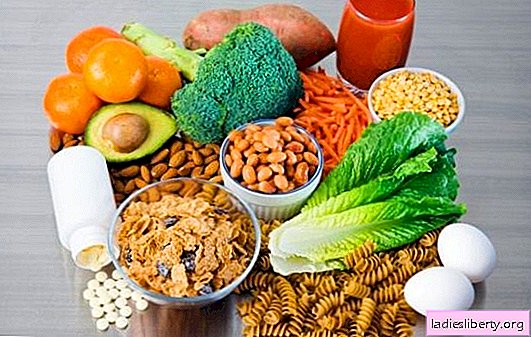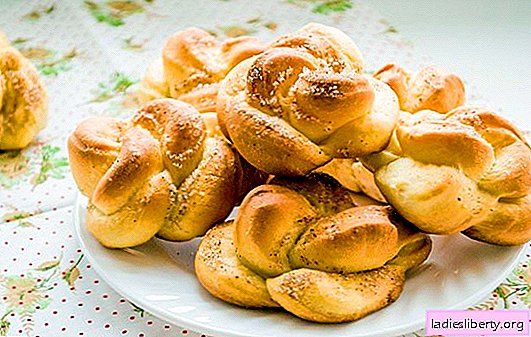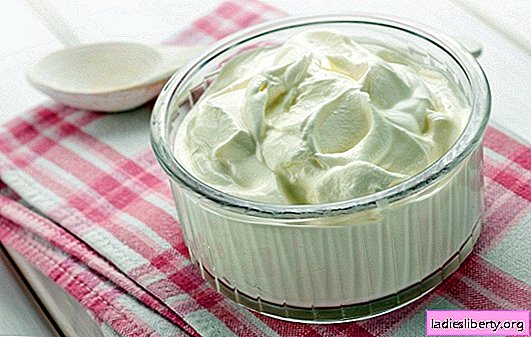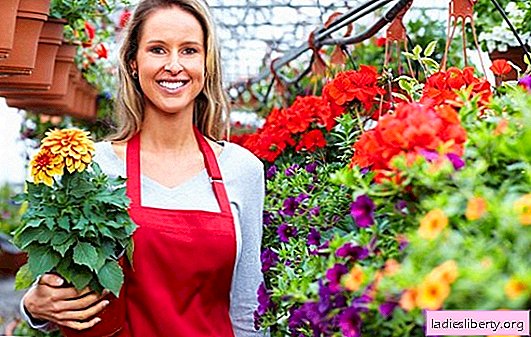
Growing chrysanthemums will thank the grower with bright modulations, large terry baskets and the duration of flowering. Most of the chrysanthemums that are common in our country do not require greenhouse conditions for growing and can decorate any area or garden.
In addition, flowers can be planted as indoor plants and enjoy the heat that solar chrysanthemums emit when it is snowing outside.
What type of chrysanthemum to choose for growing
For its most common form, chrysanthemums are called golden flower, but today the color of these colors is assembled from the whole palette of shades. Plants are represented by perennial and annual species, have one stem or shrub, a large lush flower, or just a bunch of small "stars".
Consider the most common types
Large-flowered chrysanthemum represents a plant with a height of 80 -120 cm. with a flower diameter of up to 25 cm. (!) This species is good for cutting, but may not bloom in the open field in a short, cold summer and, moreover, does not tolerate wintering in the garden.
Chrysanthemum flower - ornamental plant with a height of 30 -70 cm and a basket diameter of up to 18 cm. It is suitable for growing not only in the garden, but also for decorating the house. This type is also used for cutting and decoration of lush bouquets.
Small-flowered chrysanthemum (Korean) represents the only type of frost-resistant perennial chrysanthemums, forms a bush from 25 to 120 cm high. With numerous inflorescences with a diameter from 2 to 10 cm. It can grow in one place up to four years, decorating the garden with abundant flowering until frost. A bouquet made up of similar flowers stands in the water for a month. In addition, it is possible to take cuttings from it for reproduction.
Bloom Most species planted in open ground in May, begins in late August and in September, like other plants of the Aster family. For the winter, most perennials are harvested for storage in a cool place, but some gardeners share successful wintering experiences in the open field provided they create a quality “shelter”.
Growing chrysanthemums: the choice of planting material
What is preferred for growing: seeds, seedlings or saplings of chrysanthemums?
Chrysanthemum seeds - The cheapest way to purchase planting material, perfect for annual species. After planting, the seeds are covered with foil and subsequently fed with fertilizers based on biohumus to obtain a guaranteed flowering in the fall. Seeds can be bred and perennials, but it is difficult to achieve flowering in the first year. To obtain the result in the first autumn for perennial plants should use seedlings or seedlings.
Breeding chrysanthemum seedlings helps to adjust the vegetation period of plants under the climatic conditions of the middle and northern strip of Russia: late spring and short summer. So you can land annuals and perennials.
For seedlings, the soil should be heated to room temperature with 5–12 cm deep boxes. A soil mixture consisting of greenhouse soil, humus and peat, taken in equal proportions, is perfect. Such land, acquired in the trading network, was previously disinfected and destroyed by insect larvae, therefore minimizing the risk of infection of seedlings. In the manufacture of soil mixture at home, do not forget to ignite it at a temperature of 120 - 130 ºС.
After receiving high-quality land for planting, it is passed through a sieve and poured into boxes, the bottom of which is pre-covered with a drainage layer (broken brick or expanded clay, coarse grain, etc.). The seeds of annual chrysanthemums are embedded in the soil by 0.5 cm, and the perennial seeds are lightly pressed to the surface of the earth and sprayed from a spray bottle. Boxes covered with film or glass to preserve heat and humidity. Periodically, they will need to open, moisturize and air. The optimum temperature at which the seeds will quickly sprout should be maintained in the range of 23 -25 ºC.
With proper care, seedlings should appear together in one and a half or two weeks. The next stage of their development is accompanied by quenching. To do this, remove the covering layer from the boxes every time for a longer time, until we remove it completely. Seedling all this time should be in a warm and bright place, should not be exposed to stagnant moisture and drying.

shoots of chrysanthemums
After the appearance of two or four true leaves, the plants dive into peat cups one by one. In order not to damage the roots, the soil in the boxes is pre-moistened, gently lifted along with the ground and transferred to a new place, to the same soil composition as before. After transplantation, they are fed with a growth biostimulator (using, for example, “epin extra”) in order to successfully pass the period of adaptation and resistance to diseases.

chrysanthemum seedlings
Despite the fact that perennials are best transplanted in May, chrysanthemum saplings can be purchased from gardeners in spring and autumn. As a rule, spring seedlings do not have flowers, so when choosing early or late-flowering plants, you have to trust the words of the seller. Autumn seedlings may have baskets, in which the florist will determine their appearance and does not risk acquiring greenhouses if the disembarkation takes place in open ground.
If there are no flowers, you should pay attention to the type of leaves and stems.
Large-flowered late chrysanthemum has a large and dense green mass, durable woody stems. High-quality seedlings must have ground root, be healthy, without dryness and rot, without any signs of infection.
Among the autumn seedlings, it is worthwhile to prefer those that do not have buds, but only withered flowers, since such plants are ready for wintering in the basement. Flowers with buds with appropriate intensive care can give flowering in the winter at home.
Planting by grafting and separating young shoots does not apply to all species and applies only to perennials. This procedure is to separate the shoots from the main bush when the plant comes to life in the spring. To do this, the bush must be completely excavated. And immediately after - to plant the resulting seedlings. Propagation by cuttings also occurs in spring and consists of cutting off green shoots about 15 cm long, treating the lower part with “Kornyovin” and planting followed by periodic watering to prevent drying.
We grow chrysanthemums: the choice of land and soil for planting
The resulting planting material is planted in the ground in the spring after the threat of frost has ceased. Growing chrysanthemums requires primarily heat, so we determine the place for them on the basis of this indicator.
The same requirement is also relevant in the late, autumn, planting of small-flowered chrysanthemums, made not later than two weeks before frosts. In this case, the roots of the seedling are filled with compost, deepen the root collar by 4-5 cm, spud earth and insulate from above with leaves. Even if the winter will be harsh and chrysanthemums will freeze over with proper care, including top dressing and adaptogens, they will give new shoots in the spring.
In addition to heat on the site where the chrysanthemum is planted, there are other important requirements: the absence of water stagnation, good natural light, protection from the wind. With a lack of direct sunlight (less than five hours a day), the stems will not get stronger and stretch, the flowering period will be reduced.
When choosing the soil should be neutral or slightly acidic, rich in nutrients, without the content of fresh manure. It is preferable to plant chrysanthemums using loose biohumus mixture or humus. We should not forget about the structure of the root system, it is located in the upper layers of the soil, which dictates the rules of hydration: the roots dry out quickly, but also “do not tolerate” excess water.
Landing technique
Seedlings or seedlings should be planted in a permanent place in a trench or hole, maintaining a distance of 30 to 50 cm between rows or individual plants, depending on their variety. To further increase the root mass can be made at planting solution "Kornevina" (diluted according to the scheme: 1 gram per 1 liter of water).
After planting and moderate watering, cover the green mass with a special material (lutrasil is appropriate) for a comfortable period of adaptation and minimize the risk of falling into frost.

planting chrysanthemum seedlings
Seeds can be sown in a permanent place or for further transplantation (only under favorable conditions, otherwise seedlings are preferable).
In addition, small-flowered chrysanthemums multiply by dividing the bush. To do this, spring should dig up a bush from the ground and separate the young growth to a new place. In general, chrysanthemums should not be planted in one place for more than two or three years.
Chrysanthemum care
Amateur gardeners often prefer chrysanthemum to other flowers due to the lack of difficulty in caring for them. Plants need frequent watering, but without stagnant water. They need bio-humus and nitrogen fertilizer, but without the onset of glut, otherwise the green mass will be many, and the colors - a little. Watering chrysanthemums should be at the root, avoiding moisture on the surface of leaves and stems.
After the period of adaptation, the young and strong shoots, having the eighth leaf, should to pinch off for the formation of new branches. Extra shoots should be pinned to form a beautiful spherical shape or completely removed, transplanting them to a new place where they can easily take root. Comfortable props should be placed under tall chrysanthemums to hold the bush.
For the entire growing season, three or more supplements must be produced, expressed in the alternation of mineral and nitrogen fertilizers (ammonia nitrogen, for example). During the period of budding, it is recommended to suspend the use of nitrogenous supplements in order not to increase the growth of greenery to the detriment of the development of baskets. Mineral fertilizers are ideal potassium phosphate compounds. Fertilizers should be applied to the soil in the form of solutions, using them after rain or watering.
Application at cultivation of chrysanthemums of phosphoric fertilizers at the rate of 50 gr. on 1 sq.m. can increase the duration and the abundance of flowering. Potash supplements will give the plant healthy greens and the correct beautiful inflorescence. Potassium sulphate should be used or high-quality natural ash containing all the necessary trace elements.
It is possible to prepare natural nitrogenous fertilizer, mullein, but in this case it is important not to use fresh manure or chicken manure. A concentrated composition is prepared by diluting 2: 1 (water: manure) in water. With the subcortex, this composition is diluted with water 10: 1 (water: fertilizer) and is applied at the root at the rate of "1 liter - one bush".
Chrysanthemums respond well to the use of growth stimulants, for example, "Zircon", "Bud", "Appin", they should be used in strict accordance with the instructions.
Also well plants react to cutting old leaves, which is necessary to remove excess moisture among dense plantations or during infection.
Fight against diseases and pests when growing chrysanthemums
When contaminated soil, excessive moisture, weak immunity, non-compliance with the rules of agrotechnics during planting and care of chrysanthemums can get various fungal and viral infections. We give examples of the most common.
Mealy dew amazes stems, casting and flowers, verticillary wilting penetrates through the roots, causing the entire plant to die off, speckled mosaic damages the leaves gray rot causes rotting aspermia gives deformed flowers.

speckled mosaic
Treatment of chrysanthemums for fungal diseases It should be carried out using the following drugs: copper oxychloride to combat septoria, rust and gray rot, bordeaux powder from powdery mildew and gray rot, and copper-soap composition and colloidal sulfur will help to cope with rust. Viral diseases are not amenable to treatment at home, therefore, the diseased plants should be excavated and burned.
Nematode-infected plants should also be removed from the site, and to prevent the occurrence of these insects should be treated with formalin before planting, and the plants themselves - with a solution of phosphamide.
Landings should be checked for availability. aphidswhich is easy to identify by folded leaves and their presence on the stem. If it is not possible to remove the affected areas without damaging the whole plant, they should be treated with aktellik or aktar with a solution of soap
To fight slugs and snails useful ash wood, which powdered the ground after watering. Soap or shampoo helps to cope with meadow bugs, which cause wilting of flowers and the death of leaves.
In each of the cases we have considered, prophylactic measures should be taken to prevent diseases, strengthen plant immunity and thin out them. When fighting insects, using the preparations "Ratibor", "Fitoverm", "Aktellik", "Aktara", "Iskra" and others, we should not forget about their harm to fruit and vegetable plantings.



